The History Of Lincoln TOWN CAR

The Lincoln Town Car is a full-size, rear-wheel drive luxury sedan sold by Ford's upscale Lincoln brand. The Town Car features a V8 engine and large exterior and interior dimensions.
The Town Car is, despite recently declining sales numbers, one of the best selling American luxury cars. It also serves as America's most used limousine and chauffeured car. While relatively affordable when compared to European flagship luxury sedans, the Town Car is currently the most expensive American luxury sedan (according to base MSRP) with prices ranging from $45,815 for a basic Signature Series to $54,140 for a top-of-the-line Signature L Series. The Town Car has been available featuring ballistic protection since 2003 with prices starting at $144,995.
In 2006, Ford considered ending production of Lincoln's largest model after the planned closing of the Wixom Assembly Plant in Wixom, Michigan in 2007 causing near panic, of a transportation nature, on Wall Street. Ford ultimately decided to keep the model and move assembly to the St. Thomas Assembly Plant in Ontario, Canada where the Ford Crown Victoria and Mercury Grand Marquis, which also use the Ford Panther platform, are currently built. The Town Car's manufacture resumed at its new location in late 2007. The first Canadian-built Town Car rolled off the assembly line on January 10, 2008. The Town Car is currently the largest Canadian-made car, measuring nearly 18 feet (5.49 m) in length for a standard Town Car and 18+1⁄2 ft (5.64 m) for an L Edition.
Consumer Guide cites the vehicle's strengths as comfort, materials, and ride quality, with weaknesses cited as acceleration and handling. The Town Car is one of the safest cars available on the North American market.
It is probably not a coincidence that "Town Car" is English for "Sedan de Ville," Cadillac's model that was gaining popularity in the 1950s. Both names refer to a classic style of limousine, popular in the 1920s, which had an open chauffeur's compartment up front, but only Lincoln has sometimes attempted to make its modern models visually suggest their older namesakes. Many examples from the 1970s and 1980s have a vinyl roof style which sweeps down the center pillar as part of a raised molding, complete with opera lamps, which suggests a partition between front and rear seats, while no vinyl is applied to the front section of the roof over the driver.
The Town Car name first appeared in the Lincoln line in 1922, on a custom built Lincoln for Henry Ford.
The Town Car name later appeared on several trim levels on the Lincoln Continental from 1959 to 1980 before becoming a model in its own right for 1981. With the introduction of the smaller flagship Continental sedan in 1982, the Town Car became Lincoln's largest sedan. Since then, there have been three generations of the Town Car with additional minor redesigns, one in 1995 and another one in 2003.
Pre-1981
It later reappeared in 1959, on a special limousine-like version of the standard Continental. This first Town Car was available only in black and was identifiable by a unique padded vinyl top, which was a rarity at that time.
After its first appearance in 1959, the Town Car name went dormant for 10 years, and re-emerged as an especially plush interior option package for the 1969 Lincoln Continental.
It next appeared as a trim option in 1971, and thereafter continued through 1980 as the top-line trim option package for the Lincoln Continental. Again, the Town Car trim featured an extra plush interior along with, usually but not always, a landau vinyl roof over the rear passenger compartment. The Town Car badge has always been applied to sedans, but from 1975 to 1980, there was a similar option for coupes called the Town Coupe.
First generation
1981 - 1984
Since 1981, the Town Car has been considered a model in its own right, although this body style first appeared as the 1980 Continental. The Continental name would re-appear, on a new smaller model, in 1982 as Lincoln's premium sedan.
The first generation Town Car featured a body profile and grille similar to that of the late 1970s Lincoln Continental, although the previously covered headlights were now exposed and comprised of two adjoining square units.
This new Town Car also featured many advanced luxury options for its time. An optional full-function trip computer with digital displays showed the driver "miles to empty" and (based on driver input) an "estimated time of arrival", among other features.
Another new feature, the keypad entry system, allowed access to the vehicle via a factory-programmed (or self-programmed alternate) five digit combination. From the keypad, you could lock all doors, or, after entering your code, unlock the vehicle's doors or open the trunk lid. With this system being linked only to the vehicle, rather than a satellite, the need for drivers to share their identity with an operator in a potentially unsecure environment is not required. This popular feature is still in use on many Lincoln, Mercury and Ford vehicles.
A leather-grained vinyl full-roof covering with center pillar coach lamps was standard on base Town Car, while the padded vinyl coach roof (covering only the rear half of the roof) with a frenched (smaller) rear window opening was included on Signature Series and Cartier models (and optional on base Town Car). A cloth (Canvas) roof - re-creating the dashing look of a convertible - was optional on all models. Inside, Signature Series and Cartier models featured 6-way power seats (and manual seatback recliners) for the driver and front passenger. The traditional bench seat was gone, and all models now featured a 50/ 50 split front seat.
The introduction of the Panther platform Town Car in 1980 was also the end for 400-cubic-inch (6.6L) and 460cuin (7.5L) V8 engines in Lincoln's line-up; they were replaced with the very popular 302cuin (4942cc) V8 (carbureted from 1980-1981; and with a throttle body fuel injection system an option at the start, replaced by Port Fuel Injection in 1986 through the 1989 model year). The transmission also changed to a 4-speed automatic with overdrive. All Town Cars from 1980-1989 featured an optional trailer towing package which included: dual exhausts, a shortened limited slip differential and an improved cooling package for the engine as well as transmission.
For the 1980 to 1983 model years, a Mark VI version of the Town Car was produced with hidden headlights behind retractable (vacuum-operated) doors and the characteristic simulated spare tire shape on the trunk lid. The Mark VI sedan shared the 117-inch wheelbase with Town Car and it's two-door companion (for 1980 and 1981 only), the Town Coupe. The two-door Mark VI was built on a smaller 114-inch wheelbase, shared with Mercury Grand Marquis and Ford Crown Victoria.
1985 - 1989
For 1985, the Town Car received minor design updates. Like previous years, the scheme included a reflector running in between both taillights above the bumper mounted license plate - a design feature kept for the second generation 1990 - 1997 Town Car. But now, a single, wide reverse lamp was mounted in the center of the reflector panel (the lamps moved up from the previous bumper location). All four corners of the vehicle were slightly rounded, and the new, narrower bumpers were flush mounted with the sides of Town Car. Inside, the 1985 dashboard used satin black trim on the lower dashboard fascia and a slightly revised steering wheel with a padded center panel including a horn button - the previous year had a hard plastic center piece, with the horn button located at the end of the turn signal stalk. The large wood-tone applique used on each door panel through 1984 was replaced by an insert matching the seat upholstery.
In 1985, Cadillac DeVille and Fleetwood were both downsized and converted to front-wheel drive, and only the Fleetwood Brougham remained rear-wheel drive. Lincoln, however, continued to field the Town Car as a traditional-sized luxury car. In response to the downsized Cadillacs, Lincoln began running a series of ads in late 1985 titled "The Valet" which depicted parking attendants having trouble distinguishing Cadillacs from lesser Buicks, Oldsmobiles, Pontiacs and even Chevrolets, with the question "Is that a Cadillac?" answered by the response "No, it's an Oldsmobile (or Buick, Chevy, etc.)." At the end the owner of a Lincoln would appear with the line "The Lincoln Town Car please." The commercial saw the emergence of the new advertising line, "Lincoln. What a Luxury Car Should Be." which was used into the 1990s. The mildy-revamped '85 Town Car sold well, pushed along even further by the newly re-styled GM vehicles that not only all looked like each other, but also too similar to lesser GM models as well. Fuel prices dropped to a contemporary new low, and with operating economy less of a concern than a decade prior, the traditional layout and size of the Town Car was attractive to many buyers in the mid-80's.
Visually, 1986 was a virtual re-run of the popular 1985 model, but with the addition of the federally-mandated third brake light, mounted on the parcel shelf in the rear window. The dashboard featured more wood-tone accents (in simulated blonde walnut burl), whereas the 1985 model held satin black lower dashboard panels. Tall, four-way articulating front seat head restraints arrived in many Ford vehicles for 1986, including Town Car. The biggest mechanical change for 1986 was the switch to multi-port fuel injection for the 4.9-liter, 302-cubic-inch engine. This replaced the throttle-body fuel injection system that had been used previously. The MPFI engines are easily identifiable visually, by their cast aluminum upper intake manifolds with horizontal throttle body (vertical throttle plate), replacing the more traditional-looking carburetor-style throttle body with top-mounted air cleaner of previous Town Cars.
1987 was more of the same for Town Car, and changes were minimal. The top-notch Cartier model - which was previously only available in two-tone arctic white and platinum silver, changed to dual shades of platinum (a metallic beige), along with a new interior color in a revamped sew-style, with a sandy beige color ("Titanium") replacing the former white and gray upholstery. Also new was the available JBL single-slot CD Player.
A very minor facelift occurred for the 1988 model year, which saw an early release in the spring of 1987. Town Car now included a wide brushed metal panel on the rear of the vehicle just below the trunk lid opening. The reverse lamps, previously located in the center, now moved to the outer edges of the reflector panel. On the front end of the vehicle, Lincoln returned to the waterfall grille versus a crosshatch design from 1985-1987. Inside, the standard dashboard held a new cluster featuring round gauges set within the square bezels. The burled walnut wood-tone trim was replaced by American walnut applique, and the horn pad changed slightly with more detailed plastic trim.
For 1989, Town Car's grille featured satin black paint on the sides of the segmented grille blades (similar to Mark VII), parking lamps were changed from clear to amber, and the background of the Lincoln medallions in between the headlamps was changed from clear to black. In back, the brushed metal panel above the center reflector held a series of fine horizontal pinstripes, and the "Lincoln" logo (in a new font) and "Town Car" script emblems moved up from the panel (where they had been since 1988) to the trunk lid itself.
Second generation
1990 - 1994
In 1990, the Town Car's body went through a major redesign and a rear air suspension was added as standard equipment. That year, it was also named as Motor Trend's Car of the Year. Town Car was still available in three trim levels: Base (re-named "Executive" in 1991), Signature, and Cartier - in increasing order of price and appointment of features. Cartier was now available in several interior and exterior colors (up until now, it had only been available in a single paint scheme every year). The 1990 Town Car also marked the end of the 1970s-based angular design. The front fender extensions that contained the parking and signal lights were removed, but the traditional Rolls-Royce-inspired grille remained - but now with a modern and aerodynamic front fascia. Parking lights were now located adjoining to the grille and the headlights wrapped around the corners of the front, similar to the look of the '88 Lincoln Continental. All-new sheet metal gave Town Car a decidedly contemporary look, while styling cues, like those of the trunk lid and taillights, remained somewhat more similar to the 1980s model. The revised interior featured a new dashboard, seats, and door panels.
Introduced in 1990 were several new options that had never been available before on Town Car. A 2-position driver's memory seat was an optional on Signature (standard on Cartier). Electric seatback recliners with power inflatable lumbar support were available as well. The Electrochromic Dimming Mirror was also a carryover option from the 1989 Town Car, but now wider than before. A revised digital instrument cluster (standard on Signature and Cartier) featured a more advanced message center, but lost the "estimated time of arrival" feature (it would return in '95). Many advanced safety features were now featured on Town Car. For 1990, driver and passenger side air bags became standard. However, problems with sourcing the passenger air bag module caused many cars to be delivered without the passenger side module. A credit, shown on the window sticker, was issued for the missing component. Upon request from an owner, the credit would be taken back and the passenger side airbag module would be installed. ABS braking was optional. 1991 saw the introduction of Ford's new Modular V8, an SOHC design replacing the Ford 302 Windsor, as well as new, lightweight front and rear bumpers. For 1992, ABS braking as well as driver and passenger airbags became standard.
1993 saw a minor facelift on the front grille, and a new checkerboard pattern to the tail lamps. An electronic automatic temperature control (EATC) unit with digital display replaced the analog unit from the previous year. The electronic instrument cluster was now standard on all three models, while the automatic headlamp dimmer (part of the headlamp convenience group) was discontinued, but the autolamp system was now standard. An orange-toned walnut applique graced the dashboard and door panels.
Overall the second generation Town Car was an overwhelming sales success and quickly became one of America's best selling full-size luxury sedans. During the late 1980s and early 1990s, Town Car sales regularly exceeded 100,000 units with 120,121 Town Cars being sold in 1994 alone.
1995 - 1997
The Town Car underwent a minor exterior facelift for the 1995 model year. Changes to the exterior included smaller, clear headlights as well as additional running lights in the rear. Larger door mirrors were body-colored (formerly chrome), and were moved slightly forward on the door itself. Updated bumpers front and rear, new body side moldings, and the deletion of the small fixed window in the rear doors completed the exterior changes.
The interior was extensively revamped. Town Car received a new dashboard, seats and interior door panels. The angular interior shapes from the 1990 to 1994 model's interior were replaced by a curved dashboard that flowed into the front door panels, in fashion with the so-called "organic" design. 1995 also saw the introduction of a new steering wheel, which was used in all Panther-based sedans until 2004. In addition to the cruise control buttons, which had been steering wheel mounted since the 1970s, some models (Signature and Cartier) featured remote audio and climate control buttons as well.
Also introduced in 1995 was a new digital dash layout (standard since 1993), that featured a more italicized look to the readouts, while the exterior temperature readout moved from the dash cluster to the climate control panel. A new feature, miles to go, was added. Dual power recliners with lumbar support - as well as a two-position driver's seat memory function - became standard (formerly optional) on Signature Series. Heated seats were a new option, and door panel switches now featured (slight) illumination from a lamp located below the interior door handle. Power door lock switches were back-lit, and were mounted high up on the driver and passenger door panels. The fuel door release (previously mounted in the center dash panel) and trunk release button moved from inside the glove compartment to the lower driver's side door panel. Similar to the previous year, Signature and Cartier models featured dual clamshell storage armrests up front. Later Cartier models held dual cup holders in the rear center armrest.
With the demise of the Cadillac Fleetwood Brougham after 1996, the Town Car became the last American-made rear-wheel drive luxury car.
Special editions
1992 to 1997 saw a special Signature Series sedan come to market: the Jack Nicklaus Signature Series, which featured a green body with a white vinyl top with white leather interior trimmed in green. Most of these editions have ornaments and wording on the exterior trimmed in gold. Options included on the 1992 to 1997 Jack Nicklaus Signature Series included: Memory Seats with Power Lumbar/ Recliner, Leather Seats, and Monotone Paint.
1995 also featured another special Signature Series edition called the Spinnaker Edition which featured tri-coat paint, the Spinnaker logo on the floor mats, and 16-inch spoked aluminum wheels.
To celebrate Lincoln's 75th anniversary in 1996, the Town Car took on a "Diamond Anniversary" edition. This edition was applied to Signature Series sedans only. Options included a paint strip down the side, leather seats, wood instrument panel trim, window badging, cellular telephone, power moonroof, JBL audio system, auto electrochromatic dimming mirror w/ compass, and traction assist.
Also introduced in 1996 were the Ride Control and Touring Edition packages. Ride Control was only available on Signature and Cartier while Touring Edition was available for all Town Car models. Ride control featured an auxiliary power steering fluid cooler, 16-inch aluminum wheels, 225/ 60/ 16 tires, 3.27 axle ratio, 28.5mm stabilizer bar, and revised air springs and shocks. Touring Edition featured (depending on model), a power moonroof, JBL audio system, electrochromic automatic dimming mirror, auxiliary power steering fluid cooler, 16-inch aluminum wheels, 225/ 60/ 16 tires, 3.27 axle ratio, 28.5mm stabilizer bar, and revised air springs and shocks. Both the Ride Control and Touring Edition packages would last only between 1996 and 1997; however, the Touring Edition package would make a brief comeback during the 2000 model year.
Third generation
The 1990 body style remained primarily unchanged until the next new body style premiered in 1998, a redesign which included the removal of the car's hood ornament and more angular shapes. The Cartier model also received a 220hp (164kW) version of the Modular V8.
The more boxy Town Car design of the 1990s was replaced by a curvaceous design scheme with a downwards sloping trunk lid, pursed lip grille and cat-eye headlights.
While the Town Car lost three inches in overall length, the new Town Car was two inches wider, one inch taller, and weighed 600pounds (270kg) more. The post-1997 Town Car features a slightly longer wheelbase as well.
The interior was also completely redesigned. Door and instrument panels as well as the radio face, switches and controls were redone. Additional wood trim was added to the newly designed dashboard and the door panels. The power seat recliner and lumbar controls were moved to the door panels. Lincoln emblems remained on the door panels as well as seatbacks.
A factory option available to individual owners of Town Cars since 2001 has been a version of the Town Car with an extra six inches of rear seat legroom, designated as the "L" or "long" version. This model provides extra amenities for rear-seat passengers, including a unique rear-seat switch that allows the front-passenger seat to be moved forward as desired for extra room in the rear.
A Touring Edition also became available in late 2000. The Touring Edition featured a more powerful 235hp (175kW) version of the Town Car's Modular V8 engine, dual exhaust pipes and unique 16 inch alloy wheels with larger tires.
According to Consumer Guide the car scores above average in the premium luxury segment for comfort, room and materials but scores below average for acceleration, steering and overall technical performance. Otherwise, the Town Car has frequently received negative reviews with the car being considered "out of date." The Town Car is, however, still considered one of the best chauffeured vehicles as it receives high marks for being among the most comfortable, quiet riding and roomiest luxury cars available.
Gallery
2003 - present
In 2003, Lincoln introduced the 4th generation Town Car. Changes included stretching the grille significantly, squaring off previously rounded or 'jelly bean' angles, adding back the hood ornament, and removing the cat-eye slant headlamps of the 1998-2002 models. The Lincoln insignia was removed from nearly every facet of the interior and from the rear tail lights. The wheels on the new generation Town Car changed from an inverted bowl shape to a flush spoke design. Head rests changed from an oblong roll, to a more modern upright design.
More brushed satin metals and an analog clock were added to the interior. The radio face including climate controls received a facelift. A full-featured DVD based Satellite navigation with THX sound processors became available on the Cartier model for 2003. In 2004, it was available on the Ultimate series. For 2005 through 2007, it was available on the Signature Limited series and on the Designer Series for 2006 and 2007. The steering wheel received a facelift in 2005. In 2006, the gauge cluster received a revised analog/ digital speedometer, and now included a tachometer. On the exterior, parking sensors became hidden.
2003 also marked the last year that the Town Car was available in a trim package with the name "Cartier" (1981 to 2003). Beginning with the 2004 model year, the top-of-the-line Town Car was instead designated as the "Ultimate". The Touring edition (on the Signature model only) was dropped. The 4.6L (281cuin/ 4606cc) V8 with 239hp (178kW) and sportier handling thanks to rack and pinion speed sensitive steering was also introduced for the 2003 model year. Also new - a power trunk lid, that opens and closes at the touch of the driver's door mounted button (or through the keyless remote). The factory-equipped rear ultrasonic park assist (with two rear bumper mounted sensors) became standard on all except the Executive Series.
For 2008, many previous options have been included in the base price. The Town Car is available in two models - the $45,295 Signature, and the extended-wheelbase Town Car Signature L, priced at $50,900. These base prices do not include the mandatory $920 destination fee. As Town Car production begins to ramp down, many optional features have become standard in an effort to use up existing stock, ease assembly line procedures, and position Town Car as a better value against the competition. Leather upholstery has been standard since 1998, and the 6-disc changer is now included in the base price. The only four remaining options are $495 for HID (High-Intensity Discharge) headlamps, $895 for the chrome-finish 18-spoke wheels (in place of the standard machine-finished 10-spoke wheels), a $125 white-wall tire option, and $195 for the trunk organizer - a temporary cover for Town Car's deep center trunk well (which allows the Town Car to have a temporary flat - albeit considerably shallower - loading floor).
For 2009, the Town Car is still available only in Signature trim, with a choice of two wheelbases. The standard model is now priced at $45,815, while the longer "L" model is $51,485 (these prices do not reflect a $945 delivery fee). The four options from 2008 continue for 2009, in both price and availability.
see Fuel Tank Safety Concerns.
Model years 1996 to 2001 inclusive, using an all-composite intake manifold, are subject to coolant leaks. Late in 2005 Ford settled a class action lawsuit. See Intake Manifold Defect for details.
Lincoln Town Cars make frequent appearances in mob/ crime movies such as; Fled, Heat, The X-Files, Ocean's 11, Rush Hour, among others. In the HBO series The Sopranos, Phil Leotardo's car is a dark red third generation Town Car with a continental kit. Another appearance is in the HBO movie Recount as the primary car driven by all of the candidates in the 2000 election. They are also frequently seen as limousines/ executive cars in many different films, music videos, and TV shows. As the most chauffered vehicle in the US the Town Car is commonly seen as a limousine for high profile individuals on news broadcasts, television shows such as The Apprentice, Ugly Betty, or movies such as Al Gore's An Inconvenient Truth. The latest version of the Town Car can be seen frequently in episodes of CBS' NCIS, transporting either the Director, Jenny Shepard, VIPs or other federal agency heads.
In 1981 the Town Car was introduced in three trim levels, the base Executive Series, the mid-range Signature Series, and the top-of-the-line Cartier. The trim levels remained unchanged until 2003, when the Executive Series and Cartier names were dropped. The Signature Series did not any longer represent the mid-range model; rather it replaced the Executive Series with Ultimate designation being used for the mid-range and top model, which was formerly called the Cartier. In 2005, however, the lineup was changed again. For 2005 only, the Ultimate designation was dropped, with only the Signature Series designation being used for all three trim levels. In 2006, Lincoln introduced the Designer Series as an additional trim-level to fit in between the mid-range Signature Limited Series and the top Signature L Series.
Executive (1981 - 2003) The Executive Series was the basic trim level and thus also most affordable trim level on the Lincoln Town Car from 1981 through 2003. The Executive Series designation is still used today, but only on fleet vehicles.
Signature (1981 - 2008) The Signature Series was the mid-level trim and was also the most popular trim level from 1981 through 2003. In 2004 the trim levels were renamed, and the Signature Series was now used to describe the basic trim level and Ultimate was now used to describe the mid-level trim. In 2005 the Ultimate was dropped and all trim levels were changed to a version of Signature. The basic trim level for 2005 was called Signature, the mid trim level was called Signature Limited and the top-of-line trim-level was called Signature L. The trim level designations were revised again for the 2006 model year. For 2006 a trim level called the Designer Series was added between the Signature Limited and top-of-line Signature L.
Cartier (1981 - 2003) Cartier was used on the top-of-line Town Car from 1981 through 2003. The Cartier also featured its own version of Lincoln emblem which was stitched onto the seats. Golden Lincoln emblems on the tail-lights also became a staplemark on the Cartier Edition on 1998 through 2002 models.
Gucci (1989) According to Edmund's pricing guides for 1989, the Town Car was to be available as a Gucci Edition including a standard Carriage Roof (convertible-look). This was apparently cancelled as there was instead a "Special Edition" of the Town Car in 1989 which had a unique edition of the Carriage Roof option, with an embedded opera light extending the length of the "b-pillar", possibly replacing the proposed Gucci model.
Ultimate (2004 only) Ultimate was only used on the 2004 Town Car. Ultimate designation replaced Signature for 2004 model year and was used for the top-of-line Lincoln.
L Edition (2001 - 2008) The designation "L" was used on Lincoln Town Cars with extended wheelbases. The L editions offer an additional six inches of legroom as well as separate audio and climate controls for rear passengers. While this designation is similar to that used on other luxury flagship sedans such as the BMW 7-Series or the Mercedes-Benz S-Class, the "L" designation was never its own trim option on the Town Car. Instead the L edition was applied to the top-of-line Cartier (2003), Ultimate (2004 only), and Signature (2005 - present) Series trim levels. For the 2001-02 versions, the "L" edition shares its rear doors with regular Town Cars and can best be identified by its extra-thick B-pillars. The "L" version has had its own rear doors from 2003 onward to have regular size B-pillars; these doors also give the "L" a resemblance to the Grand Marquis.
Designer (2006 - 2008) The Designer Series is an upper-middle trim level in between the mid-level Signature Limited and top-of-the-line Signature L. The Designer Series is roughly $1,000 more expensive than the mid-level Signature Limited with a starting MSRP of $45,915. This trim includes two-tone interior accents, a special higher quality leather called Provence leather. The rear seats also include four way adjustable head restraints exclusively on this trim for the standard wheelbase. On the exterior special chromed B pillars and Chrome wheels are included with this package.
Trim level timeline
Over its twenty-five year run, the Town Car has become one of best selling luxury cars of the United States and received several awards and recognitions by the mainstream media in the process.
- Roominess. According to Forbes, Edmunds.com and NCTD, the Town Car is the most spacious luxury sedan under $200k US; an honor easily proven by the interior's generous dimensions. A standard wheel-base Town Car features 112.7cuft (3.19m3) of interior volume versus 105cuft (3.0m3) in the Mercedes-Benz S 600 or 111cuft (3.1m3) in the extended wheelbase BMW 760iL. The difference is even greater when comparing the Signature L Series with its enormous 120.5cuft (3.41m3) of interior space.
- One of the best chauffeured cars. Forbes magazine repeatedly named the Town Car one of the best cars to be chauffeured in along with other, often more expensive flagship sedans, such as the Mercedes-Benz S-Class, BMW 7-Series and Lexus LS. The Town Car Signature L features a rear seat comfort package which not only provides rear seat passengers with audio system and rear compartment climate controls, but also features a control function which allows for the rear seat occupants to move the passenger seat forward, a feature exclusive to few ultra-luxury sedans. In addition to its many amenities, the Signature L also features an unrivaled 46.9in of rear legroom, and 60in of rear shoulder room.
- Highest Possible Safety Rating. The Town Car is the first car in automotive history to receive a five-star rating in all five categories" - Lincoln web-site. The Town Car is also the only vehicle to receive a five star rating in all five categories for five years in a row, from 2001 to 2006.
- Motor Trend Car of the Year. In 1990, upon the introduction of the second generation Town Car, the vehicle received the honor of being named Motor Trend Car of the Year.
From Wikipedia, the free encyclopedia
More About Lincoln TOWN CAR
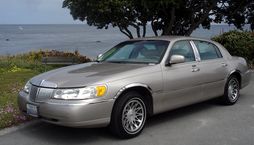
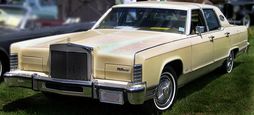
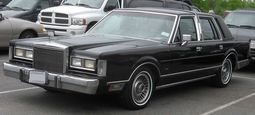
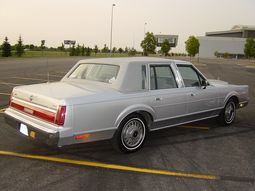
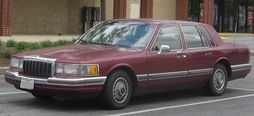
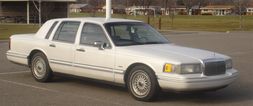
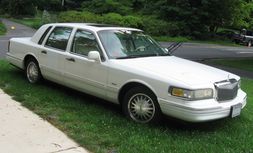
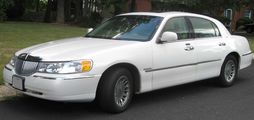
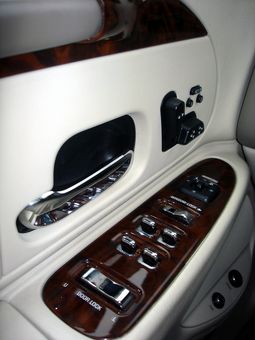
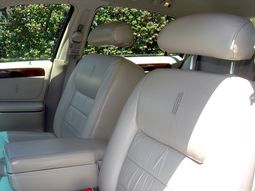
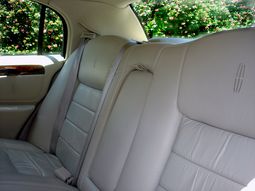
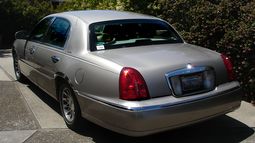
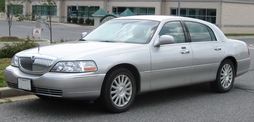
|